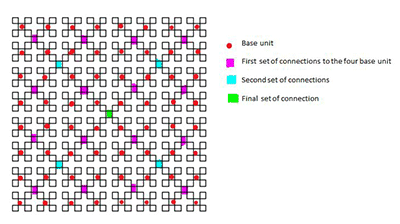
Connecting the Dots: Math, Art and the Everyday

Visual art was an essential part of everyday Indian life and used as a means of cleansing the soul of the household. Women would clean their front porches and, on them, create motifs using dry or wet rice powder sometimes enhanced with colored sand, or flower petals. Practiced throughout India, it was known by different names according to region, such as Rangoli, Kolam, or Alpana. My family called the art form Muggu.
 As a child, I watched my mom carefully practice in the night and, in the mornings during special auspicious months, make big Hanuman and Krishna Indian deities. It was exciting and stimulating to see her expertise in pouring the rice flour perfectly, flawlessly into dots, lines and curves. Such skill would put a machine to shame. As early as 6 years old, I used to practice small designs using statistical graph paper.
As a child, I watched my mom carefully practice in the night and, in the mornings during special auspicious months, make big Hanuman and Krishna Indian deities. It was exciting and stimulating to see her expertise in pouring the rice flour perfectly, flawlessly into dots, lines and curves. Such skill would put a machine to shame. As early as 6 years old, I used to practice small designs using statistical graph paper.
Routinely creating Muggu helps to keep one spiritually and psychologically content, stimulating the artistic side of the brain and connecting it to everyday life. The practice trains the mind to focus. The correct way to draw is to stand and bend the body (not to sit), which stretches the body along with one’s creativity. In this posture, blood flows naturally to the brain.
Muggu uses organic materials as medium and the earth as material. It all starts with placing the dots in equal distance and developing a symmetrical composition, either by connecting the dots or by looping around them. Many small designs are completed with a single starting and ending point. In this way, everything is linked in a systematic manner.
 Muggu as Recursive Pattern in Anklets of Krishna
Muggu as Recursive Pattern in Anklets of Krishna
Muggulu patterns illustrate the mathematical process of recursion, where smaller units are repeated many times in a sequence to form a similar, bigger pattern.
In the design, “The Anklets of Krishna,” smaller parts are connected in an orderly fashion to form a larger recursive pattern. The entire pattern is completed without a disconnection at any point. In this case, the pattern is repeated four times. I have color coded every stage of the connections.
The example starts small and is expanded by continuing to enlarge the same sub-pattern, creating a complex overall design. The result is a recursive pattern that explains the fundamental mathematical principle on recursion.
Muggulu designs may be floral, a deity, or any pattern, but they all start with dots that are developed by either connecting the dots or going around them to form shapes.
Brinda Pamulapati, owner/managing director, of Venvi Art Gallery in Tallahassee, can be reached at (850) 322-0965 or visit www.VenviArtGallery.com